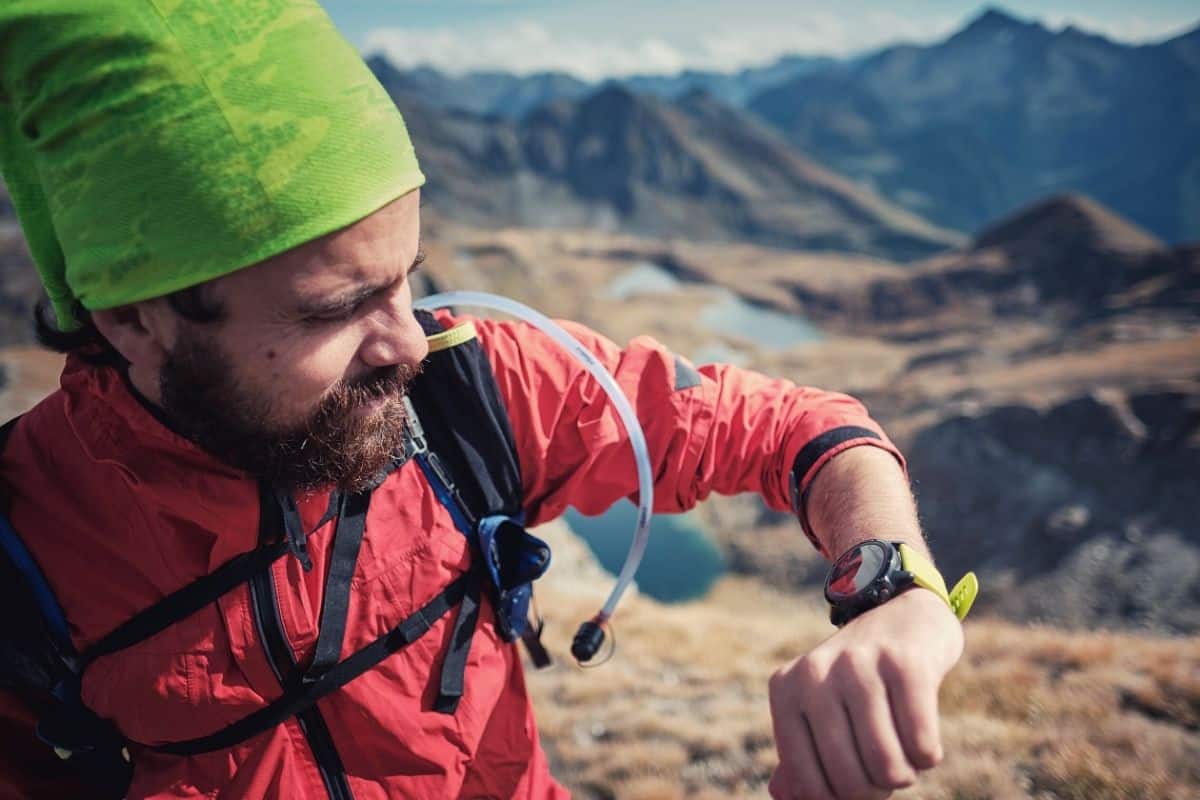If you’re a serious hiker or backpacker, you may want more information on your wrist beyond the current time. While timekeeping on the trail is essential, an ABC watch, equipped with an Altimeter, Barometer, Compass, and thermometer, can indicate bearing, altitude, and upcoming storms. Some GPS navigation watches can also display color topographic maps directly onto your wrist.
With much to consider, we’ve trialed many watches in the field to create a shortlist of our top 10. Covering a range of price points and models for various activity types, we crowned the Garmin Instinct Solar as our overall winner.
Other top hiking watches on our recommendation list include the Suunto Traverse, Garmin Fenix 6X Pro, Garmin Fenix 5X Plus, Casio Pathfinder PAG240-1, Suunto Core, Casio Pro Trek PRW-3500, Suunto Spartan Sport HR Baro, Suunto 9 Baro, and the Garmin Enduro.
To help you find the perfect wristwear for your adventures, we’ll guide you through what to look for in a great hiking watch, including enhanced features like an altimeter, barometer, compass, GPS, thermometer, or heart rate monitor, along with considerations for durability, comfort, and battery life.
Do
Don’t
Table of Contents
At a Glance: Quick Recommendations
-
Editor’s Choice:
Garmin Instinct Solar
“Bells, whistles, and unrivaled practicality at an affordable price point.” -
Best Budget GPS Hiking Watch:
Suunto Traverse
“Still one of our favorites thanks to its intuitive controls, friendly price tag, and accurate GPS.” -
Best GPS Hiking Watch:
Garmin Fenix 6X Pro
“Pricey, but a great pick for those who want detailed topo maps and myriad features.” -
Worth a Look:
Garmin Fenix 5X Plus
“The pared-down, previous iteration of the Fenix 6X still holds its own.” -
Best Backpacking Watch:
Casio Pathfinder PAG240-1
“Ideal for long-term trail travel.” -
Best Altimeter Watch (ABC Without GPS):
Suunto Core
“A great choice for anyone who doesn’t need any frills like music storage or digital mapping.” -
Best Mountaineering Watch:
Casio Pro Trek PRW-3500
“A rugged, solar-powered watch that makes up for what it lacks in aesthetics with outstandingly accurate altitude tracking and user-friendliness.” -
Best Outdoors Watch:
Suunto Spartan Sport HR Baro
“A shoo-in for users who dabble in multiple outdoor activities.” -
Most User-Friendly:
Suunto 9 Baro
“Lacks the sophisticated maps of some competitors, but is highly intuitive and rich in customizable features.” -
Best for Thru-Hiking:
Garmin Enduro
“Incredible battery life, lightweight, and great for tracking everything you could wish to track.”
Best Watches For Hiking By Category
Budget: Casio Pathfinder PAG240-1, Suunto Core, Casio Pro Trek PRW-3500
Best GPS Hiking Watches: Garmin Instinct Solar, Garmin Fenix 6X Pro, Garmin Enduro, Suunto Spartan Sport HR Baro
Best Battery Life: Garmin Instinct Solar, Casio Pathfinder PAG240-1, Suunto Core, Garmin Enduro
Which is the Best Hiking Watch?
Hitting the trails over the last season we’ve tested many watches and have shortlisted the following favorites.
- Garmin Instinct Solar
- Suunto Traverse
- Garmin Fenix 6X Pro
- Garmin Fenix 5X Plus
- Casio Pathfinder PAG240-1
- Suunto Core
- Casio Pro Trek PRW-3500
- Suunto Spartan Sport HR Baro
- Suunto 9 Baro
- Garmin Enduro
Garmin Instinct Solar
Editor’s Choice
Key Features:
- 3-axis compass and barometric altimeter plus multiple global navigation satellite systems (GPS, Glonass, and Galileo)
- All-day health monitoring and Pulse Ox
- Tracking: heart rate, stress, sleep, and body battery energy monitoring
- Smart notifications and automatic data uploads to the Garmin Connect
We selected the Garmin Instinct Solar as our overall winner due to its affordability, ease of use, excellent battery life, great digital mapping, and ability to customize data for a wide range of activities.
The Instinct Solar is good for 24 days in smartwatch mode and 30 hours in GPS mode, making it a great pick for backpackers and thru-hikers. While its digital mapping isn’t as detailed as the Fenix 6X Pro, it’s perfectly clear and easy to read, as is the customizable data shown on the screen.
Like all Garmin watches, the Instinct Solar pairs with Garmin’s awesome companion app, Garmin Connect, which allows you to track, analyze and share health and fitness activities recorded by your watch.
PROs
- Affordable
- Awesome battery life
- Pairs with Garmin Connect
- Solar charges
- User-friendly
CONs
- No topo maps or data
Bottom-Line: Cheaper than its competitors but a standout in every important metric.
Suunto Traverse
Best Budget GPS Hiking Watch
Key Features:
- GPS and GLONASS navigation systems
- Wireless syncing with Bluetooth to your computer, tablet, or smartphone
- Digital compass that tilt-compensates and can be calibrated for declination
- FusedAlti function provides accurate altimeter readings
- Weather/Storm Alarms
The Suunto Traverse earns our award for best budget hiking watch due to its sleek style, advanced yet easy-to-navigate range of features, and all at a reasonable price.
Any hiking watch needs to get its ABCs on point, and the Suunto Traverse nails this. We found the FusedAlti/barometer and compass functions to be consistently accurate, and in our opinion, out in front of its competitors.
The GPS combined with the Movescount phone app creates a seamless one, two – allowing you to plan and create routes, easily locate your position, track your route and sync it all wirelessly via Bluetooth.
Constructed with scratch-resistant sapphire crystal glass, stainless steel bezel, and a nylon textile strap, the Traverse is as hardy as it is sleek and stylish. Having passed no less than 19 tests, and meeting military standards in the process, it won’t let you down in the wilderness.
PROs
- GPS/GLONASS bearings were very accurate
- Navigation is a snip with the Movescount App
- Stay ahead of storms with weather warnings
- Very straightforward to configure and use
CONs
- Battery dwindles to ~8 hours in GPS mode
Bottom-Line: If you are looking for the best GPS watch for hiking, then the Suunto Traverse watch deserves your undivided attention.
Garmin Fenix 6X Pro
Best GPS Hiking Watch
Key Features:
- Wrist-based heart rate and Pulse Ox2 sensors track your fitness activities
- Preloaded ski maps for more than 2,000 resorts around the world
- Syncs to streaming services
- Listen to music without your phone
- Power Manager
- Hydration tracking
- Animated workouts
- Preloaded activity profiles for trail and track running, swimming, running, biking, hiking, rowing, skiing, golfing, and (many!) more
With the ability to connect to GPS, GLONASS, and Galileo satellite systems, along with full-color topographic maps, we found the Garmin Fenix 6X Pro Plus to be the top GPS watch on the market.
The 6X Pro offers 14 days of battery life in smartwatch mode and 36 hours in GPS mode. Its on-screen topo maps are as detailed as those on any other watch in our review and it has more sport profiles than even the most active human could possibly need. It’s also waterproof to 100 meters, pairs with a top-notch companion app, and is fully customizable.
While more expensive than the Garmin Instinct Solar, we found the 6X Pro to be a better navigational tool on account of its larger screen size and superior mapping, both of which will make it worth the extra cost for some.
The only downside to the 6X Pro is that it takes a little time to figure out all those settings and features – okay if you’re patient and love your tech, tricky if you (like the author of this post) prefer your gadgets to be a little more straightforward and intuitive.
PROs
- Up to 14 days between charges in smartwatch mode
- Detailed, preloaded topo maps
- Large screen
- Rugged
- Waterproof
- Advanced training metrics
CONs
- Not the most intuitive
- Pricey!
Bottom-Line: An outstanding navigational tool that includes a full, top-end suite of features for health and fitness tracking, plus much more!
Garmin Fenix 5X Plus
Worth a Look
Key Features:
- Multisport GPS watch ideal for multiple outdoor sports
- GPS, GLONASS, and Galileo enabled
- Full-Color Topo maps that connect with Garmin data to help find the best routes
- Garmin Pay allows you to leave your credit cards at home
- 3-axis compass, gyroscope, and barometric altimeter
If the Garmin Fenix 6 X Pro is too pricey for you, the older version, the Fenix 5X Plus, is worth considering. With the ability to connect to GPS, GLONASS, and Galileo satellite systems, along with full-color topographic maps, it remains one of the best GPS watches on the market today.
Thanks to hundreds of thousands of user data points the Fenix 5X is able to select the optimum route to take when you sync it with Garmin Connect. This feature is great for finding new hiking, cycling, or running routes.
In addition to its superb navigational functions, this Garmin hiking watch has all the usual features you would expect in a high-end smartwatch, with compass, barometer, etc, along with a couple of more unusual ones. Connect to your bank, and you can now pay contactlessly with the Fenix, while also simultaneously listening to your favorite tracks on Spotify. Not bad, right?
While the interface and mapping aren’t as refined as on the Fenix 6x Pro, this remains a great option if you want to save a handful of $.
PROs
- Impressive GPS accuracy
- Full-color topographic maps & ability to find user-created routes
- Spotify and contactless-enabled makes it useful around town as well as on the trail
CONs
- GPS mode is very draining on the battery
- Function navigation can make it tricky to use
Bottom-Line: If you are looking for the best GPS watch on the market, you’ll be hard-pressed to do better than the Garmin Fenix 5X Plus.
Casio Pathfinder PAG240-1
Best Backpacking Watch
Key Features:
- Large-capacity solar storage battery which can keep the watch charged for up to 6 months
- All your ABCs and the ability to track weather changes
- Easy to read dual-layer LCD screens & easy to navigate menus
- Great backlight with afterglow for night vision
Ideal for backpacking or thru-hiking, the standout feature of the Casio Pathfinder PAG240-1 watch is its solar-powered battery, which, when fully charged, lasts an impressive 6 months.
Having been on the market for nearly a decade, this classic watch shows no sign of going out of fashion. Some may find it not the most stylish of watches, being a little clunky, but its big buttons and straightforward menu structure make it a cinch to use.
It may be a little stripped-down compared to some of the other models in this review, as it has no GPS, but its ABC functions are pretty accurate, making it a solid watch if you don’t need/want the GPS functionality.
PROs
- Easy to use
- Solar-powered battery keeps it going for months
- Easy to read display
- Light weight and ruggedness make it ideal for multi-day backpacking trips
CONs
- Very chunky, particularly for slimmer wrists
- No GPS
Bottom-Line: It does the ABCs well, and as it can last a full AT thru-hike on one charge, the Casio Pathfinder wins our award as the best watch for backpacking.
Suunto Core
Best Altimeter Watch (ABC Without GPS)
Key Features:
- Barometric alt. accurate to 29,500ft and displays in 3ft intervals.
- Records and displays elevation loss/gain for the session in addition to the current elevation
- Storm alarm feature when bad weather is approaching
- Digital compass can be locked into destinations bearing
- Sunrise/sunset times
- Heart rate monitor
Our top prize for the best non-GPS altimeter watch has to be awarded to the Suunto Core. The Core’s altimeter is accurate up to 29,500ft and measures in 3ft increments (compared to 10-20ft for other hiking watches we tested). The Core also logs your altitude for up to 7 days, allowing you to download and review all your stats once you’re off the trail (or ski slope).
A super cool feature is its ability to automatically switch between altimeter and barometer based on your movement – if you are ascending/descending it attributes barometric air pressure changes to this. If you are stationary, on the other hand, then it will associate barometric changes with weather fluctuations.
To top it all off, it will sound a storm alarm when it notes a substantial air pressure drop.
This is one of our favorite hiking watches in terms of its design and would be happy to wear this one out on the town. It’s let down a little bit, however, when it comes to viewing the display in either low light or extremely bright conditions.
PROs
- Great accuracy
- Stylish looking, even off the trail
- Simple but easy-to-read graphs
- Awesome battery life
CONs
- Need to navigate through 3-4 menus to get to certain features (no advanced training required, but a touch annoying nonetheless)
- The display is a little dark, particularly in poor light
Bottom-Line: If you’re specifically after the top altimeter watch, then plump for the Suunto Core.
Casio Pro Trek PRW-3500
Best Mountaineering Watch
Key Features:
- Solar power battery which can last up to 6 months on a single charge
- Automatically receives atomic clock time calibration signals for accurate timekeeping
- Has all your ABCs and will record your elevation gain/loss
- Several alarms and countdown functions
- Water-resistant
With its simple and straightforward design, we present the Casio ProTrek PRW-3500 T-7RC as our top pick for best mountaineering watch, and a contender for the best ABC watch to boot!
Like its cousin the Casio Pathfinder, the ProTrek has a solar-powered battery that will allow it to function for five to six months without the need for recharging.
As you would expect, it has all the altimeter barometer compass functions needed in a good hiking or mountaineering watch. But due to its overall accuracy, we feel it outperforms other ABC watches (watches with a compass, altimeter, and barometer) in our review when it comes to mountaineering. In addition, its altimeter is good to 32,800ft and will naturally track your total ascent/descent progress.
As with most Casio watches, they certainly ain’t the prettiest to look at, although the plastic look is almost synonymous with the brand and may appeal to some.
PROs
- Solar charging – no batteries/cable charging required
- Altimeter accurate up to 32,800 ft.
- Great accuracy and ease of use
CONs
- Looks very plasticky
Bottom-Line: Head for that summit safe in the knowledge that the Casio ProTrek won’t let you down.
Suunto Spartan Sport HR Baro
Best Outdoors Watch
Key Features:
- Conquer the outdoors with over 80 possible sport/activity modes
- Great durability with steel bezel and mineral crystal glass
- GPS/GLONASS navigational systems work with Movescount App
- Barometer, compass & altimeter lets you know where you are and what’s happening with the weather
- Water-resistant
The top outdoor smartwatch was awarded to the Suunto Spartan Sport HR Baro, primarily for its impressive range of 80 preloaded sports and activity modes. It also goes far beyond the features you’d expect of a typical fitness watch, with GPS, altimeter, barometer, and compass.
Like its cousin, the Suunto Traverse, you can download all your workout/trip data to the Movescount app and relive your adventures, and/or set new goals.
The Spartan has a sleek, simple design which in our opinion gives it a stylish look. In addition, it’s a pretty rugged watch and will survive the usual backcountry clattering that happens to all our equipment from time to time.
PROs
- Preloaded with over 80 sports/activities
- Sleek, lightweight design makes it ideal for trail running, swimming, and even climbing
- Good battery life
CONs
- Don’t lose or forget the power cord, it’s proprietary so you may struggle to borrow one.
Bottom-Line: If you are looking for a fitness tracker that you can use for a wide variety of activities such as running, hiking, cycling, swimming, then the Suunto Spartan Sport HR Baro is our pick for the overall best outdoors watch.
Suunto 9 Baro
Most User-Friendly
Key Features:
- Over 80 sport modes
- Four predefined battery modes – Performance, Endurance, Ultra, and Tour – deliver from 25 hours to up to 170 hours of recording time with GPS tracking
- FusedTrack™ algorithm combines GPS and motion sensor data to improve track and distance accuracy to extend battery life
- Pairs with Suunto Movescount app
- Rugged design can take scrapes and falls
The Suunto 9 Baro is the most user-friendly and intuitive option we tested, using a simple, clear touchscreen interface with only two buttons. The duo of large buttons also allows you to operate and navigate settings without removing your gloves, making it a win-win.
The 9 Baro features a GPS, altimeter, barometer, thermometer, compass, and heart rate monitor, and also has crystal-clear digital mapping. On top of this, you can customize and download your own routes using the Suunto Movescount app.
PROs
- High accuracy of the GPS system
- Easy to use
- Up to 7 days of continuous GPS tracking
- Waterproof to 100 meters
- Sapphire glass
- Touchscreen
CONs
- Expensive
- Quite bulky
Bottom-Line: All the features you would expect from a high-end GPS watch, and user-friendly to boot. To our mind, the best GPS watch for hikers who like to keep things simple.
Garmin Enduro
Best for Thru-Hiking
Key Features:
- Full ABC functionality
- Activity/fitness tracking (optical heart rate monitor, sleep tracking, step tracking, floor climbing)
- Measures performance (pulse ox, lactate threshold, performance condition, and much more)
- Custom workouts
- Multiple sport modes
- Multisport modes
- Garmin Pay
- Garmin Connect app
The Garmin Enduro is one of the lightest watches on our list, coupled with its multi-week battery life, it’s a shoo-in for long-term adventuring off the grid.
Unlike many high-end GPS watches, the Enduro doesn’t have digital mapping or music storage, so it’s not the best bet for you if either of these features are ‘must-haves’. However, it has every other feature included in the Fenix 6 series base models and beats all of the Fenix 6 models for battery life.
If you already have a handheld GPS device or prefer using old-fashioned paper maps while out on your wanders, the Enduro is a great choice.
PROs
- Exceptional battery life that’ll last up to 50 days in smartwatch mode (65 days with solar)
- Battery life of 1 year with solar in battery saver mode
- Plethora of modes
- Ultralight
- Precision GPS
CONs
- Lacks the mapping and storage of the Garmin Fenix 6 X Pro
- Pricey
Bottom-Line: A great pick if you plan on being on the trail for multiple consecutive days and if you don’t require digital mapping.
What to look for in a GPS Hiking Watch?
When choosing the right hiking GPS watch for you, asking the questions listed below can assist in narrowing down your decision.
- What is the primary purpose you’ll use the watch for?
- Which watch features are a necessity?
- Which extra features are ‘nice-to-haves’?
- Does the style matter to you?
- What are you willing to pay for all the above?
If you aren’t sure which features and functions you require we’ve listed the most important below.
- Hiking Features/Enhanced Functionality
- Durability
- Comfort
- Battery Life
Hiking Features/Enhanced Functionality
The enhanced functionality of hiking or backpacking watches provides the user with a wider breadth of data to help make your backcountry trip safer and more enjoyable.
The following list has a rundown of the most common enhanced functions and what you use them for.
- Altimeter
- Barometer
- Compass
- GPS
- Thermometer
- Heart Rate Monitors

Altimeter
An altimeter measures altitude, derived from the Latin “altitudo” meaning “height,” which is a measure of your vertical position above sea level. Knowing your elevation in combination with a map is a useful way of determining or double-checking your position.
This is particularly valuable in areas where taking sightings with a compass for triangulation is tricky e.g. in dense forest or barren wilderness with few discernable landmarks/rock cairns or if navigating at night.
A watch with a hiking altimeter will determine this in one of two ways:
1. Barometric Pressure
An altimeter barometer watch uses atmospheric pressure to calculate your approximate location above sea level based on the premise that atmospheric pressure decreases as altitude increases.
Barometric altimeter watches, however, will only give you an approximate elevation since temperature variations and local weather conditions also influence atmospheric pressure, resulting in some uncertainty on your precise altitude.
To ensure accurate readings, an altimeter barometric watch needs to be calibrated often, with some of the more advanced models doing this automatically. Although, we would caution that you should also learn to do this manually as technology can (and does) fail.
2. Hiking Watches with GPS
GPS-based altimeters use the same principles to identify your height as your lateral (x/y) position i.e. multiple satellites are used to pinpoint your location on the earth’s surface.
GPS altimeters suffer from the fact that you need to be in the line of sight of at least 4 geo-orbiting satellite systems to gain an accurate location, which can be problematic if you are in the mountains, canyons, or valleys of the backcountry.
As a result, for use in the backcountry, we would recommend picking a non-GPS barometric altimeter over a GPS altimeter due to their (typically) greater accuracy in locations in which we outdoors folk normally find ourselves. However, if you want something that doesn’t require calibration and you can live with the uncertainty, then don’t rule out a watch with a GPS altimeter.
Lastly, a cute feature of some watches is the ability to download the altitude data to your computer or web application and make a topographic profile of your hike.
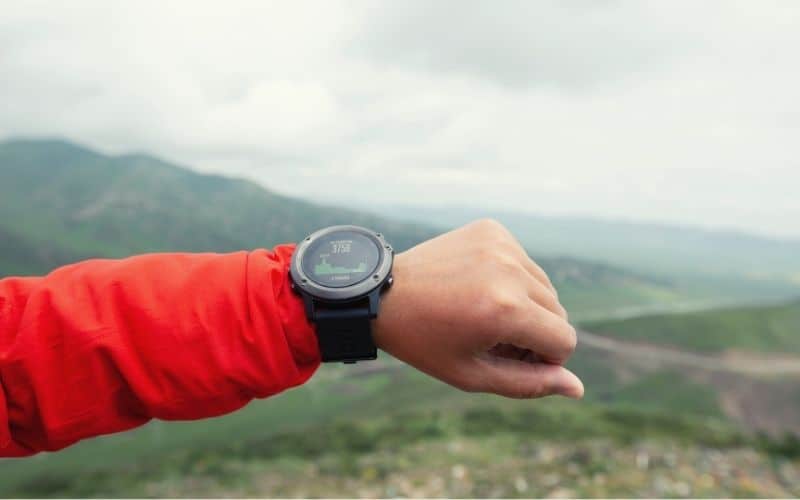
Barometer
Your hiking watch’s barometer function measures atmospheric pressure and tracks air pressure changes over time to predict upcoming weather events.
Increasing atmospheric pressure means that weather conditions are improving and conversely decreasing atmospheric pressure suggests that less than stellar hiking conditions are on the way (think precipitation: rain, fog, snow).
A sharp decrease in pressure usually indicates a storm is on its way, and many of the hiking smartwatches in this review will alert you with an alarm, giving you time to get your rain gear on, or to seek shelter.
Having some advanced warning of the likely weather forecast can be a massive help in staying dry(er) and more comfortable, and in extreme cases, staying safe by seeking shelter.

Compass
A compass is your principal means of navigation, showing the four cardinal directions (North, South, East, and West) along with your current bearing (the direction you are facing). It works by measuring the earth’s magnetic field to accurately determine which way is north. Any watch without a compass isn’t a watch for hiking in our opinion.
While a compass on your watch is useful for getting a sense of general direction, we would again caution that it should not entirely replace your traditional compass for two simple reasons. First, you’ll quickly find sighting and triangulation with a map much easier with your handheld compass, and secondly, and more importantly, technology can fail.
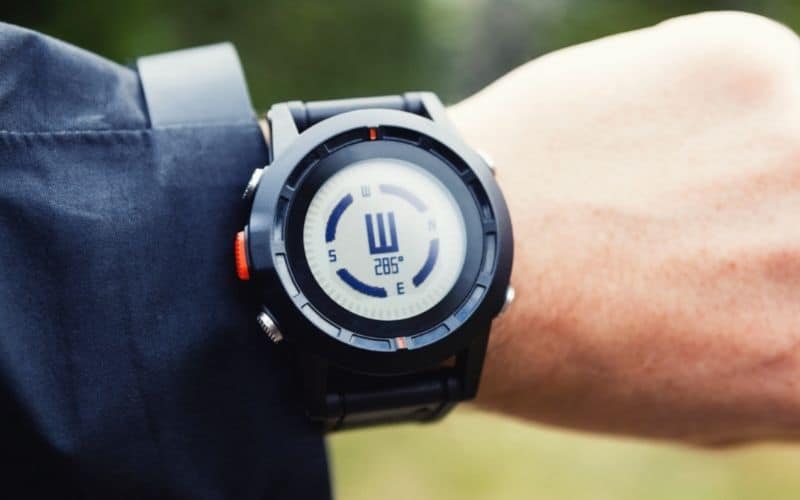
GPS
As mentioned, the GPS function uses orbiting satellites to pinpoint your location on earth, providing access to your current coordinates, speed, distance traveled from the previous waypoint, ascent/descent, and your position relative to various landmarks on the GPS map system. This feature is available on the more advanced hiking watches.
Probably most useful is that GPS watches can import your chosen route, allowing you to see your current position relative to where you should be. In addition, after making it safely home again, you can download all this GPS data to relive your trip in digital form.
The biggest downside to GPS watches for hiking is they all suffer from short battery lives – I’ve yet to see a watch that can survive more than a day or two with the GPS tracking turned on.
Therefore, if you are going on a longer trip your options are likely restricted to only having the GPS signal turned on for limited periods and/or bringing along some form of charger, either a battery pack or solar charger.
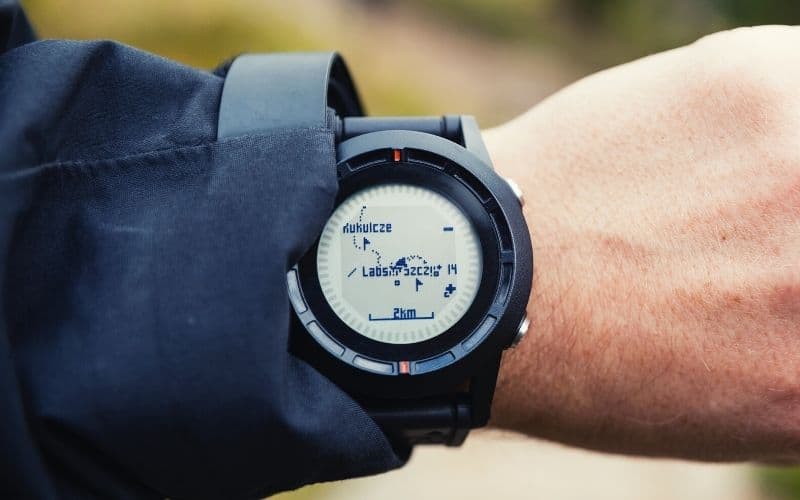
Thermometer
Thermometers are a feature on some watch models and provide an idea of the air temperature.
We’ve yet to be convinced as to how useful such a feature is, as your own internal sense of the external temperature will let you know if it’s time to throw on your jacket or peel off a layer. Additionally, as the temperature sensor sits next to your wrist, temperature readings from watches tend to be skewed slightly by your body heat.
As far as we are concerned, a “nice to have”, but certainly not a must-have feature.
Heart Rate Monitors
Watches with a heart rate monitor (HRM) measure your body’s electrical pulses, either through a transmitter/receiver built into the watch (measured through the wrist) or by using a transmitter chest strap and receiver built into the watch.
As with the thermometer, this isn’t a particularly necessary feature but does allow you to keep an eye on how well you are pacing yourself and gives you an overview of your fitness levels.
This feature is most useful for those who are hiking to improve their fitness (as you’ll be able to monitor your improvement over time by referring to your heart rate) or those “metric geeks” (such as myself) who love nothing more than poring over data/trends.
A word of caution – even the most sophisticated wearable heart rate monitor isn’t particularly accurate.

Durability
Everyone who has hiked or backpacked knows that trips, slips, and falls can happen due to a wet rock or misplaced foot, and as such, your equipment needs to be sturdy and durable enough to survive such misadventures.
Many good hiking watches are protected with sapphire glass lenses which offer increased protection from scratches as compared to the traditional mineral crystal glasses you’ll find on regular watches. Expect to find a higher price tag for that protection though.
While getting wet is generally something to be avoided while out in the wilderness, staying dry is often something that isn’t feasible. To that end, all (good) hiking watches are water-resistant, often marked up to 100m (10 ATM), which seems like a little bit of overkill (even if you’re trekking through the Amazon and decide to go for a dip every evening).
Suffice to say, anything above the roughly water-resistant 30m point should be sufficient to weather even extreme downpours and the occasional bit of skinny dipping along the route.

Comfort
Because your watch may be the only item you wear continuously for days on end (we hope you change your underwear occasionally), it should also be comfortable. When buying, look for softer materials in the wristband and read user reviews to understand how comfortable the watch is during all-day use.
Also, durable and rugged straps and added features may result in bulk that makes it awkward, particularly for those of us blessed with slender wrists. Does it fit snuggly, or does it chafe like hell after only 2km?
Don’t underestimate how important comfort is, and ultimately, if you forget you are wearing your watch, then comfort-wise, you have chosen well.
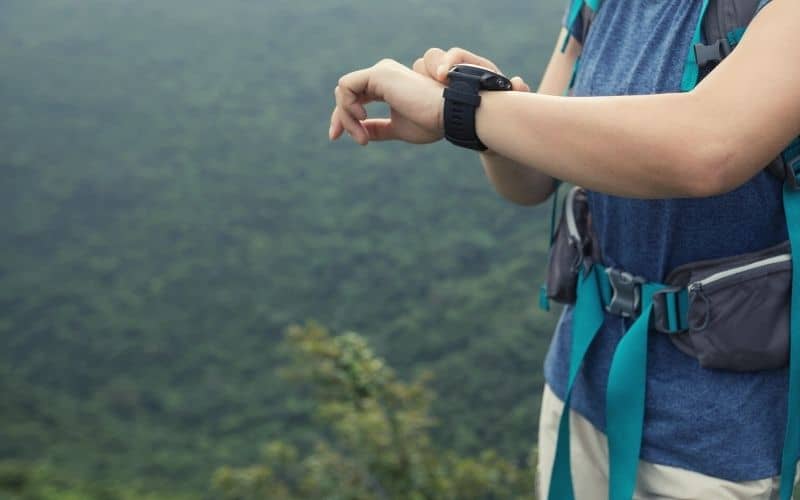
Battery Life
Depending on the duration of your typical trip into the backcountry, battery life may or may not be an important consideration in an outdoor watch. All the hiking watches reviewed here should last through a one or two-day outdoor adventure without the need to search for your nearest electrical socket.
However, for those of us who expect to be out for multiple days, weeks, or even months, then longevity from your mountain watches battery is something you may wish to prioritize. Certainly, hauling a spare battery pack is a possibility, but that’s extra weight on your back.
Generally, there are two broad-brush correlations here, 1) more features = shorter battery life and 2) higher price (for a similar number of features) = longer battery life. This is why we would typically recommend a simpler watch for those more advanced backpackers who expect to be out for weeks on end.
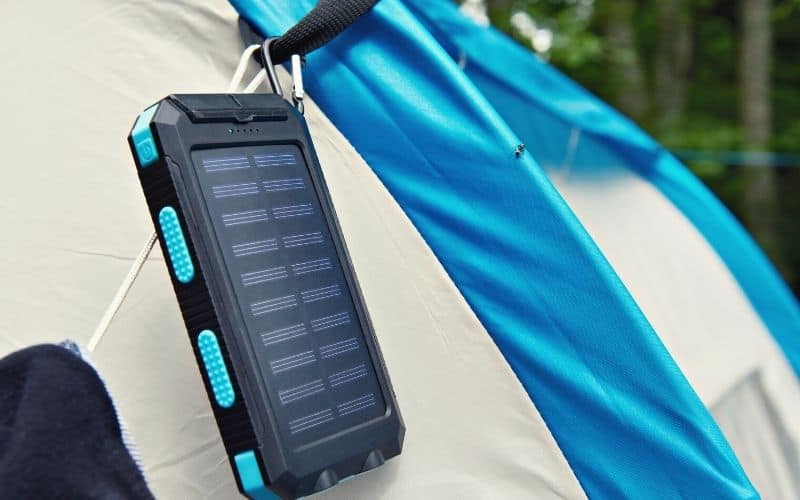
Best Watch for Hiking: The Verdict
If you’re looking for a high-end model that will do practically everything except cook your food upon reaching camp, we recommend the Garmin Instinct Solar or Garmin Fenix 6X Pro. Both are for serious outdoors enthusiasts who appreciate precise, detailed data, numerous bonus features, and top-notch mapping.
If you are on a budget or want to spend your money on other pieces of kit and/or don’t require enhanced functionality like GPS, then we recommend a simple ABC watch like the Casio Pathfinder or Protrek, or the Suunto Core watch.
If you’re keen on GPS or simply want more stylish, sleek designs with enhanced functionality – particularly other features such as thermometers, atomic time-keeping, and HRM – then you can spend a little more and get yourself the non-baro version of the Suunto 9 or Suunto Traverse.
If you liked this post, please feel free to share it with your friends. And if you have any comments or questions, drop us a line in the box below!
